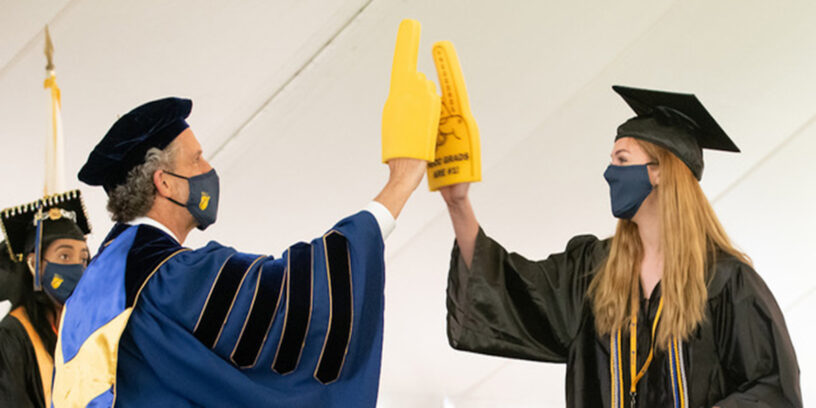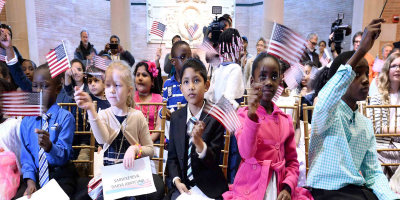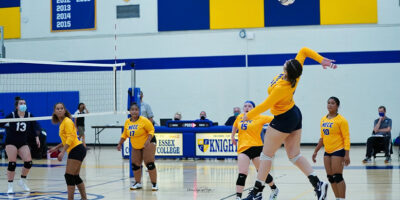I love my job.
Each and every day I have the privilege of working with incredibly talented and dedicated educators at a community college—an institution I have always prized dearly—toward our common mission of providing affordable, easy to access education to lift up the lives of our students and enrich the communities we serve.
It just doesn’t get any better than that.
Today is the last day of my tenth year as the president of Northern Essex Community College.
As I look back and celebrate a decade in this job I love so much, I can’t help but think about some of the unexpected turns, happy coincidences and lucky breaks (even if they didn’t always seem that way at the time) that led to me becoming what I sometimes refer to as “the accidental president.”
Career Planning
First, let’s get this out of the way: No ten-year-old in the history of the world has ever looked up at Mom and Dad over the dinner table and said, with a grin of conviction on her or his face, “I want to be a community college president when I grow up!”
It’s never happened.
Not once.
Firefighters and doctors, sure.
Teachers, veterinarians, movie stars, and professional athletes in abundance.
But no community college presidents.
It’s just not on the radar.
Me?
At age ten, I wanted to be a journalist.
I had a fourth-grade teacher named Ms. Proctor who told me I was a good writer. She even gave me a giant stuffed pencil that said, “I’m a BIG-time writer!”
My favorite television show was Lou Grant, starring Ed Asner as a curmudgeonly Los Angeles newspaper editor who mentors and guides the reporters in his newsroom through covering difficult stories and facing moral dilemmas.
I wanted to be Lou Grant—but with hair.
So, I wrote stories.
I became the editor of my high school newspaper in Del City, Oklahoma, and went to work as a layout artist, back in the day before computer desktop publishing, when that job meant cutting printed text with X-Acto knives, running it through wax machines, and pasting it on giant blue-lined copy boards, at a small local paper called The Midwest City Sun.
Accidents #1 and #2: Bye, Bye, Semper Fi and Hello, Dolly!
When it came time to think about college, I had heard that Northwestern, the University of Missouri at Columbia, Emerson College, and a few other places had some of the best Journalism programs, but, like a lot of our community college students, my family was new to the college-going experience, didn’t have much money, and were suspicious of forms asking a lot of personal questions.
It all seemed impossibly out of reach.
I nearly followed my father’s path into the Marine Corps, and hopefully the NROTC, as a way to pay for my education, when a local bank came up with a modest scholarship for me that paid for my tuition ($150 a semester) at nearby Oscar Rose Junior College.
My first declared major was Journalism, though that quickly changed when I took an Introduction to Theatre course and discovered that I enjoyed acting, along with playwriting, directing, scenery and lighting design, and everything else to do with the performing arts.
If it weren’t for that scholarship from Del State Bank, I might have attended another college, completed a four-year degree, along with Marine Corps officer training, and served as a lieutenant in the First Gulf War in 1991, liberating Kuwait.
If it weren’t for that Introduction to Theatre class, I might have pursued a career as a journalist, and by now, might be struggling, along with most of the industry, to survive in a journalism landscape devastated by social media fragmentation and corporate conglomeration. (Even back in 1985, the Introduction to Mass Media course I took as a college freshman was predicting the end of journalism as we knew it because of some upstart “comic strip” newspaper called USA Today…)
Instead, by 1991 I had earned a double-major bachelor’s degree in English and in Theatre, a master’s degree in Speech/Theatre, and had moved from Oklahoma to Michigan State University for my doctoral degree.
Accident #3: An Act of Congress
Although I did end up working my way through college in a variety of jobs that included summer theatre, television commercials, and even a little film work, I never wanted to make my living as a professional actor.
I knew soon after discovering the performing arts that what I enjoyed most was teaching them.
I also knew (or thought I did) that I did not understand or enjoy young children (sorry, Big Sis T and Little Sis Z, I did get over that); and could not imagine teaching middle-schoolers or high school students (wrong kind of drama for me).
My destiny, I was sure, was to become a college professor.
By 1989, when I completed my bachelor’s degree, the universe seemed to agree with me.
On September 13, 1989, the front page of the New York Times ran an article about a study led by the former president of Princeton University, William Bowen, that concluded:
Unless preventive steps are taken soon, American colleges and universities face a major shortage of faculty members starting in the next several years…
Perhaps most surprising of all, the greatest shortages were not predicted in STEM fields, where we find them today, but instead, among the disciplines, like Theatre, in the Humanities and Social Sciences where, the “Bowen Report” warned, the nation needed to double its production of Ph.D.’s.
To the generations of crestfallen doctoral program graduates who have come up short in the job market in the decades since then, let me promise: I am not making that up.
One of the reasons for the predicted shortage was a wave of anticipated retirements. In the 1950’s and 1960’s, America began opening up access to higher education to more people.
In the decade between 1960-1970, community colleges like NECC (founded in 1961) were opening at a rate of one each week.
A lot of new professors were hired, and thirty years later they had to leave their posts, thanks to mandatory retirement ages.
Federal rules regarding the age of retirement were established, and are occasionally amended, by the Age Discrimination in Employment Act (ADEA) of 1967. By 1986, Congress had amended the act numerous times, prohibiting mandatory retirement ages for most workers in the United States, but college professors were exempted, and still required to put away their chalk (yes, we still used chalk back then) and leave their classrooms by age 70.
And so it was that, just as I started my master’s degree program in the fall of 1989, the Bowen Report could confidently predict the Academy would desperately need me and a bunch of other newly minted Ph.D.’s a few years later.
Then, while I was in the doctoral program at Michigan State University, Congress asked the National Academy of Sciences to study the ADEA and its impact on college teaching. In 1993, they recommended removing the exemption for college professors that required them to retire by age 70. Congress agreed, and prohibited mandatory retirement ages at colleges, just as the ink was drying on my dissertation in 1994.
I entered an academic job market that year that was still battered by an economic recession from the early ‘90’s, now coupled with delayed retirements, as more faculty stayed on the job, particularly in the humanities and social sciences.
Accident #4: Big Tobacco Pays Up
And so, I cobbled together a living as an adjunct instructor at a local community college; a writer for magazines and newspapers, and for Gale Research, the company that published encyclopedias (now online journals) for any topic you can think of; and as a part-time technical director for a scene shop, building sets and teaching carpentry, painting, and lighting to aspiring designers and stagehands.
As it turned out, there was a need for more, and better trained, stagehands out there in the Midwest.
So I went to work with area employers like the Wharton Center at Michigan State University, the Lansing Convention Center, and the Interlochen Center for the Arts in northern Michigan, along with one of the oldest trade unions in America, the International Alliance of Theatrical Stage Employees (IATSE), to create what at the time was the first federally registered apprenticeship program for stage technicians in the country.
The students in Lansing Community College’s Michigan Stage Technician Apprenticeship Program took classes in carpentry, rigging, welding, and basic electricity, along with theatre history and dramatic literature; and they received paid on-the-job training as stagehands for the travelling tour of Phantom of the Opera, at Rolling Stones concerts, on movie production sets, and other glamorous, and not-so-glamorous, places.
My jack-of-all-trades approach to earning a living actually turned into my first full-time job as a college professor, teaching classes in the Liberal Arts Division of the college, while coordinating an apprenticeship program in the Careers Division.
And my approach to working with employers and community organizations caught the attention of the college’s leadership at a particularly opportune moment.
In 1998, the “Big Four” tobacco companies entered into a Master Settlement Agreement with the attorneys general of 52 states and territories, as a result of tobacco-related healthcare expenses. The companies agreed to significantly reduce the marketing of their products, especially to youth, and to pay states more than $200 billion over 25 years.
States were required to use some portion of the settlement toward anti-smoking campaigns, but could do whatever they wanted with the rest.
The state of Michigan decided to invest in a network of Michigan Technical Education Centers (M-TECs), that would provide on-demand workforce training, based on the needs of local employers, from robotics and advanced manufacturing for the automotive industry near Detroit, to lumber mill operations near Escanaba in the Upper Peninsula.
Lansing Community College wanted to build two of these centers, and they needed somebody to help bring everyone together and manage the effort.
So, in 1999, I left the faculty for my first job as a college administrator with the vague-sounding title of “Director of Special Projects” for the college’s Business and Community Institute, tasked with launching a couple of “M-TECs” and expanding workforce training services.
That same year, I participated in my first formal leadership development program, the Chair Academy, and a good friend and mentor told me, for the first time, “You are going to be a college president one day.”
I thought she was nuts.
At first…
Accident #5: Break a Leg!
That job prepared me, a couple of years later, to become a Dean of Academic and Student Services for a large community college system just outside Detroit; then, five years after that, the Vice President of Academic Affairs here at Northern Essex Community College.
Along the way, I did begin to aim more purposefully toward a college presidency someday, participating in more leadership development experiences, studying higher ed policy and funding issues, and paying careful attention to the leadership styles of presidents around me.
For all my preparation, though, I needed at least one more happy coincidence to end up in this job I love so much today.
When the last president of Northern Essex Community College, David Hartleb, announced his plan to retire in 2011, the college’s board of trustees formed a committee and hired a consultant to run a national search for his replacement.
Two of the most important tasks for any college board of trustees are determining the annual budget and hiring the president.
When the search process began in 2010, Massachusetts and the entire country were still struggling to emerge from the Great Recession that began in 2008. Although enrollment at NECC and other community colleges was climbing, with many people still out of work and looking for retraining, the state funding picture was bleak.
The college needed a skilled, preferably proven, leader who could build on the strong conditions President Hartleb had created, and successfully navigate the many financial and political challenges that were ahead of us.
I applied for the job and made it through the screening process and the first round of interviews to become one of three finalists, alongside a provost from Maryland and a seasoned, highly accomplished president in Ohio who had previously led the New Hampshire Community College statewide system.
The odds favored that seasoned president, who was looking to finish his career back in New England, though things took an unexpected twist.
As the Eagle Tribune described in a fittingly headlined story on December 23, 2010, “Tight Vote on New NECC President,” when the time came to cast their ballots, four trustees voted for the veteran president from out of state, and five voted for me, the “up-and-comer” from inside the college.
Although all five of those votes were necessary and counted the same, you could say the deciding one came from the student trustee at the time, Babak Alian.
He was a Theatre major.
An aspiring actor.
I saw all of his performances with NECC’s Top Notch Players.
Bravo, Babak!
After that first 5-4 vote, the trustees cast their ballots again, and unanimously approved my appointment as the fourth president of Northern Essex Community College, pending similar approval by the Massachusetts Board of Higher Education, which happened a short while later.
I am grateful to Babak, to the other four trustees who were willing to take a chance on this “up-and-comer,” and to all of the trustees, faculty, staff, and students who put their confidence in me from that day to this one, and who I am privileged to serve today.
I am also grateful for all of the unexpected turns, happy coincidences and lucky breaks that helped me become “the accidental president.”
I love my job.
Ten Years of Memorable Moments: A Gallery
As I look back and celebrate a decade in this job I love so much, the pictures in this gallery represent just a few of the many memorable moments along the way so far:






